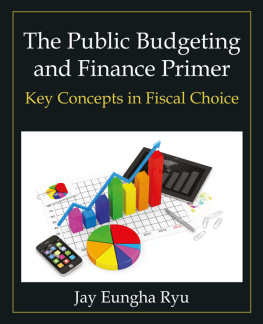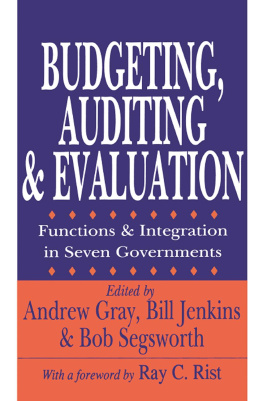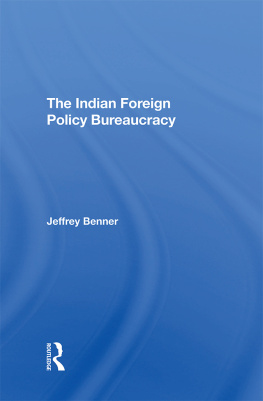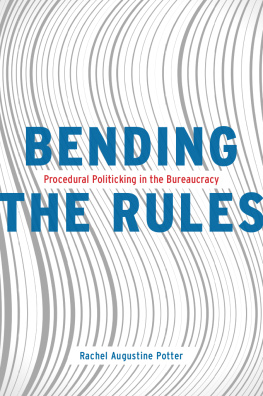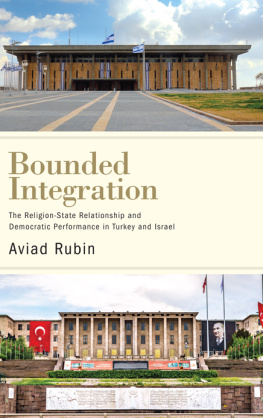Bounded Bureaucracy
and the Budgetary Process
in the UNITED STATES
Bounded Bureaucracy and the Budgetary Process in the UNITED STATES
JAY EUNGHA RYU
First published 2011 by Transaction Publishers
Published 2017 by Routledge
2 Park Square, Milton Park, Abingdon, Oxon OX14 4RN
711 Third Avenue, New York, NY 10017, USA
Routledge is an imprint of the Taylor & Francis Group, an informa business
Copyright 2011 by Taylor & Francis.
All rights reserved. No part of this book may be reprinted or reproduced or utilised in any form or by any electronic, mechanical, or other means, now known or hereafter invented, including photocopying and recording, or in any information storage or retrieval system, without permission in writing from the publishers.
Notice:
Product or corporate names may be trademarks or registered trademarks, and are used only for identification and explanation without intent to infringe.
Library of Congress Catalog Number: 2011008560
Library of Congress Cataloging-in-Publication Data
Ryu, Jay Eungha.
Bounded bureaucracy and the budgetary process in the United
States / Jay Eungha Ryu.
p. cm.
Includes bibliographical references and index.
ISBN 978-1-4128-4289-1 (acid-free paper)
1. BudgetUnited States. 2. BureaucracyUnited States.
3. Centralization in governmentUnited States. I. Title.
HJ2051.R98 2011
352.4'80973dc22
2011008560
ISBN 13: 978-1-4128-4289-1 (hbk)
Bureaucracy has been criticized from various fronts. It has been often depicted as the main source of all governmental inefficiency and ineffectiveness. Of course, we have been witnessing numerous attempts of reforming bureaucratic organizations. Ironically, this book finds that even such initiatives to reform bureaucratic malfunctions cannot be successful without utilizing a certain aspect of bureaucracy itself. It is much more ironic that I started this book project as a part of my ongoing research efforts to criticize bureaucracy and recommend alternatives to bureaucratic organizations. In my previous studies, I found that bureaucracy cannot effectively deliver public services if the services span multiple jurisdictions beyond any one bureaucratic organization. Collaborative network management can overcome the limits found in bureaucratic service delivery.
Several years ago, I started analyzing whether and how bureaucratic procedures in large government organizations delay information processing and augment organizational conflicts. Unlike my scholarly belief, empirical evidence has been indicating that a certain aspect of bureaucracy, such as bureaucratic centralization, is crucial in enhancing cognitive and analytical capacity of decision makers and reducing organizational conflicts. In addition, the functions of bureaucracy were observed to be significantly influenced by its surrounding political environments. But all in all, bureaucratic centralization significantly improves bureaucratic performance to a certain degree. So, it occurred to me that negating bureaucracy in its entirety might not be a solution to reform bureaucracy. Bureaucratic reform initiatives such as performance budgeting systems have been sweeping virtually all levels of governments. The empirical findings I have obtained over several years suggest that even such reform initiatives are not guaranteed if we completely disregard bureaucracy itself.
The financial market collapse in 2008 resulted in a sudden drop in tax revenues for governments. During the recent years, record-high deficits triggered by the market collapse have been plaguing all levels of governments and necessitating fiscal austerity. One might probably think of an adequate level of bureaucratic centralization as an add-on mechanism to control governmental waste, if not a completely standalone alternative to bureaucratic malfunctions. Of course, whether and how bureaucratic centralization leads to budget control is an open invitation to future rounds of research. However, the main findings in this book at least imply that expedited information processing and reduced organizational conflicts rendered by bureaucratic centralization might contain some of governmental inefficiencies. In this regard, I believe that this book will be a good start for great debates between scholars and practitioners.
Finally, I wish to thank Alex Maza for his research assistance throughout multiple phases of this book project. He made great suggestions on the general tone of this book. Brandon Lawson participated in the later phase of this project. He also made insightful comments on how to edit the entire book for lay readers. I also thank, for support for this research, the Voinovich School of Leadership and Public Affairs and Department of Political Science at Ohio University. In addition, I thank my best friend and wife, Jeongwon, and my daughters, Sueyeon and Leah, for their sustained encouragement for the completion of this book. All remaining errors in this book, of course, pertain to myself.
When policy makers make their decisions, they receive various policy inputs and process them into policy alternatives. For instance, budget decision makers receive demands from interest groups, get data on available tax revenues for upcoming fiscal years, and focus on political power transition that might affect annual budget size. However, budget decision makers, especially in governments, usually do not have enough time and resources to process all such information they obtain from their surrounding environments. In addition, they do not have cognitive and analytical capacities to review the information. This phenomenon has been described as bounded rationality .
Institutional procedures and limits further augment the bounded rationality. For example, there are numerous statutory provisions that control the size of revenue, spending, and budget deficits. The complicated legal, institutional, and organizational procedures limit the cognitive capacities of human decision makers. In particular, bureaucratic organizations have been specifically blamed for amplifying the bounded rationality. Bureaucracies typically have highly centralized and hierarchical structures, along with standardized procedures of operation. They have been blamed for various dysfunctions such as conformity to standard rules rather than achieving core missions, oppression of human freedom due to hierarchical control, and irresponsiveness to the public due to adhering to internal procedures of operation. In addition, bureaucratic organizations were criticized for their inability to efficiently and effectively deal with public problems beyond their organizational boundaries, which span multiple administrative jurisdictions. Strong collaboration among multiple organizations is recently suggested as a way to improve organizational performance of bureaucratic organizations (Bingham and OLeary 2009).
However, bureaucratic organizations were originally invented to enhance information-processing capacities (i.e., cognitive and analytic capacities) of individual decision makers. In particular, bureaucratic centralization was suggested as a way to expedite information processing and reduce organizational conflicts. Central offices in bureaucratic organizations were supposed to function as a storage center for various information sources. They share the information sources with line units (e.g., departments and agencies) and also relieve their computational burden. Bureaucratic centralization was also expected to reduce tensions and conflicts among departments and agencies in bureaucratic organizations.



